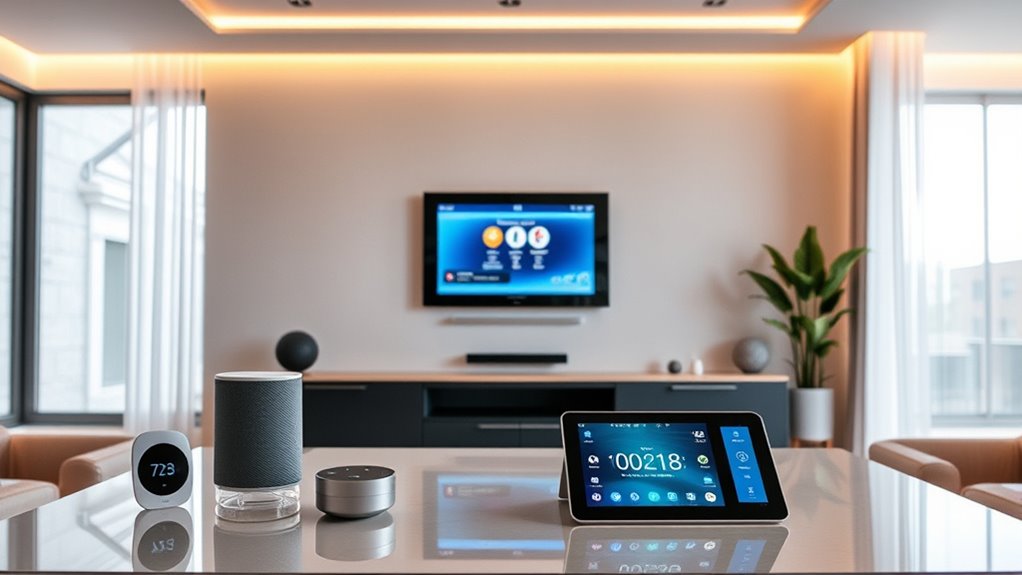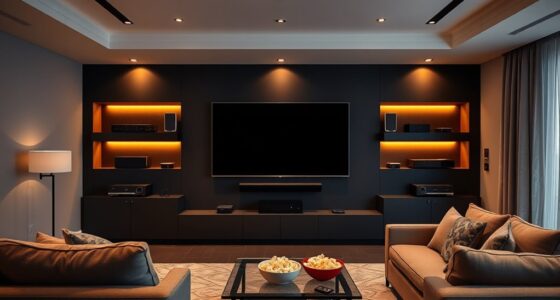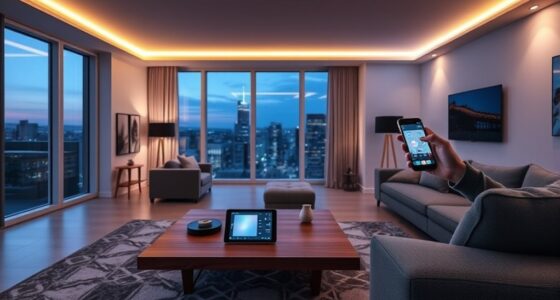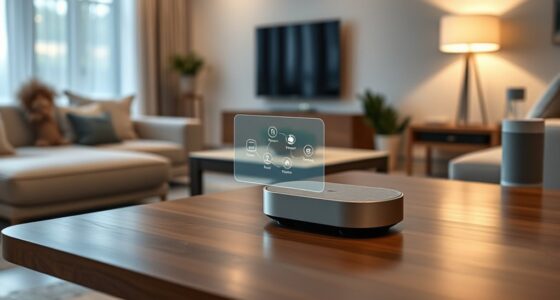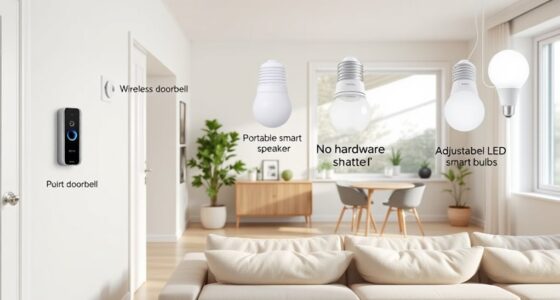A smart home lets you control and automate household devices for added convenience, security, and efficiency. You can use voice commands, remote apps, or routines to manage lights, thermostats, and security cameras easily. To get started, choose compatible, secure devices that fit your needs, then set them up with simple pairing steps. By creating automations, you enhance daily life while keeping your system safe. Keep exploring how to expand and maintain your smart home hassle-free.
Key Takeaways
- Home automation uses technology to control household systems for convenience, efficiency, and security.
- Choose compatible devices that work with popular platforms like Alexa, Google Assistant, or Apple HomeKit.
- Set up devices by powering on, connecting to Wi-Fi, and following app instructions for seamless integration.
- Create automations and routines to respond automatically to triggers like time, location, or device activity.
- Regularly update firmware, secure your network, and expand gradually to maintain system security and reliability.
Understanding the Basics of Home Automation
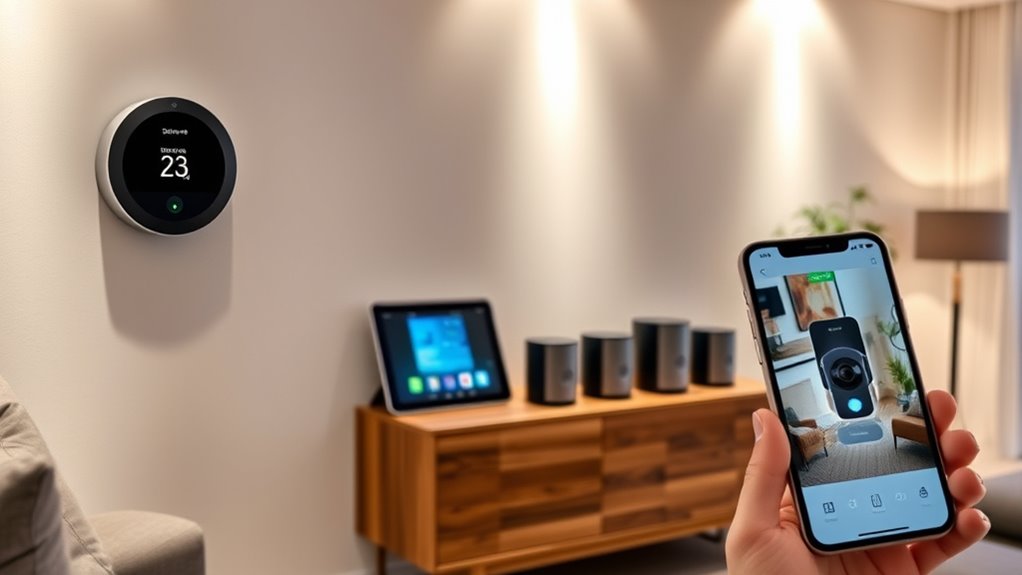
Home automation involves using technology to control and automate household systems, making everyday tasks more convenient and efficient. With voice control, you can manage devices hands-free, simply speaking commands to turn on lights, adjust thermostats, or play music. Security cameras are another key component, providing real-time video feeds you can monitor from anywhere. These cameras help keep your home safe, allowing you to check on your property remotely and receive alerts for suspicious activity. Understanding these basics helps you see how automation enhances your daily routines and security. It’s about making your home smarter, more responsive, and easier to manage. By integrating voice control and security cameras, you start building a connected environment tailored to your needs. Proper setup and understanding of home automation costs can help you plan your investment effectively. Additionally, exploring smart home market growth can give you insight into the expanding options and innovations available for your home. Knowing about home theater projectors can also improve your entertainment setup, making your home more enjoyable and immersive.
Choosing the Right Devices for Your Smart Home
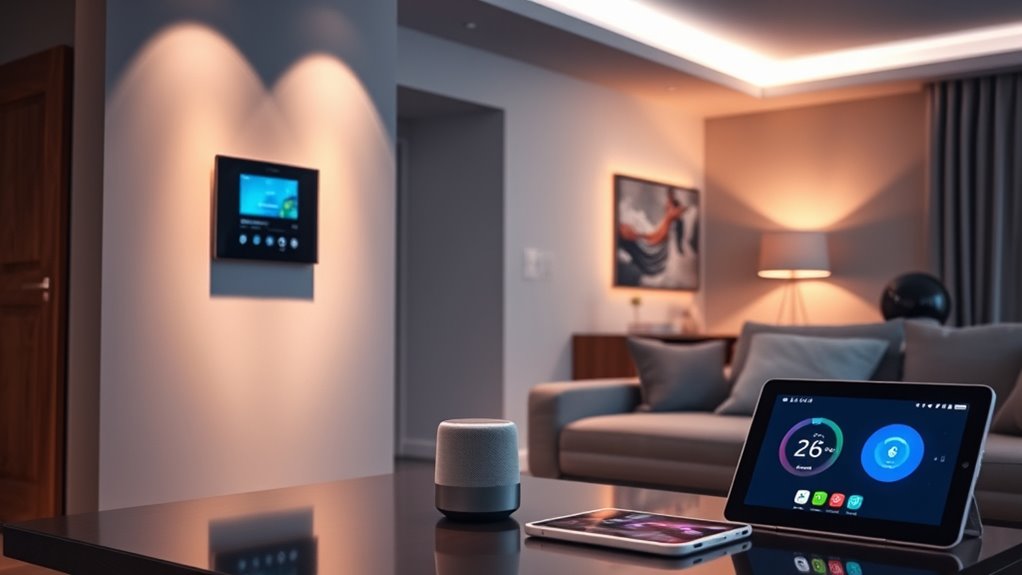
Choosing the right devices is key to building a smart home that truly meets your needs. Start by considering brand compatibility to guarantee all devices work seamlessly together, reducing frustration and technical issues. Look for products that support popular smart home platforms like Alexa, Google Assistant, or Apple HomeKit. Equally important is device security; choose devices with strong encryption and regular firmware updates to protect your data and privacy. Avoid cheap or unverified brands, as they often lack security features and can compromise your home network. Focus on devices that are reliable, easy to use, and compatible with your existing setup. Incorporating security features into your device selection is essential to creating a secure, integrated smart home that functions smoothly and keeps your family safe. Additionally, evaluating device reliability can help ensure consistent performance over time, reducing the need for frequent troubleshooting or replacements. Ensuring your selected devices prioritize privacy policies can further safeguard your personal information and enhance your overall smart home experience.
Setting Up and Connecting Your Smart Devices
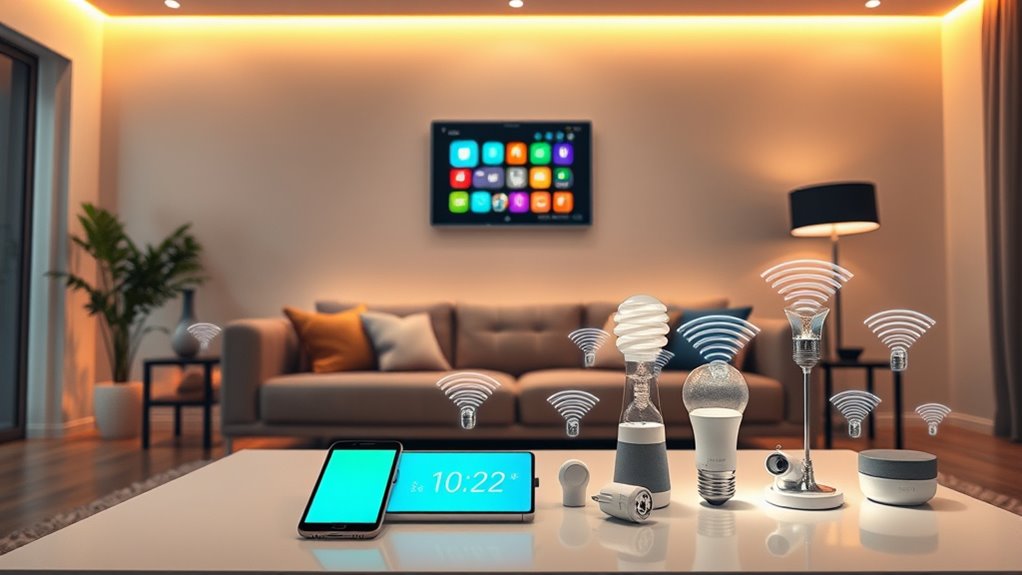
Getting your smart devices connected and configured might seem intimidating at first, but with a clear step-by-step approach, it becomes straightforward. Begin by powering on your devices and downloading the relevant apps. Follow the pairing instructions, usually involving connecting to your Wi-Fi network. Once connected, ensure your devices are compatible with your chosen voice control system, enabling easy voice commands for lights, thermostats, or locks. For security integration, link your smart security devices—like cameras or alarms—to your main app or hub. This seamless setup allows you to monitor and control your home effortlessly. Keep your firmware updated during setup to avoid glitches. Additionally, consulting best practices for smart home setup can help optimize device placement and network security. With everything properly connected, you’ll enjoy a smarter, more responsive home environment with enhanced security and voice-controlled convenience.
Creating Automations and Routines

Creating automations and routines allows you to customize your smart home to respond automatically to your habits and preferences. You can set up actions based on time, location, or device triggers, making daily life more seamless. For example, you might create a routine that turns on lights and plays music when you say a voice command like “Good morning.” Security protocols are essential to guarantee your automation system remains safe from unauthorized access. Use routines to activate security cameras or lock doors automatically when leaving home. Here’s a simple example of automation options:
| Trigger | Action | Security Protocols |
|---|---|---|
| Time of day | Turn on lights, play music | Enable alarm system |
| Voice command | Lock doors, adjust thermostat | Authenticate voice ID |
| Leaving home | Power off devices | Enable security cameras |
| Arriving home | Unlock door, turn on lights | Disable alarms |
| Motion detection | Alert or record footage | Secure access controls |
Additionally, incorporating security best practices such as encryption can help ensure your automation system remains protected from cyber threats.
Tips for Maintaining and Expanding Your Smart Home System
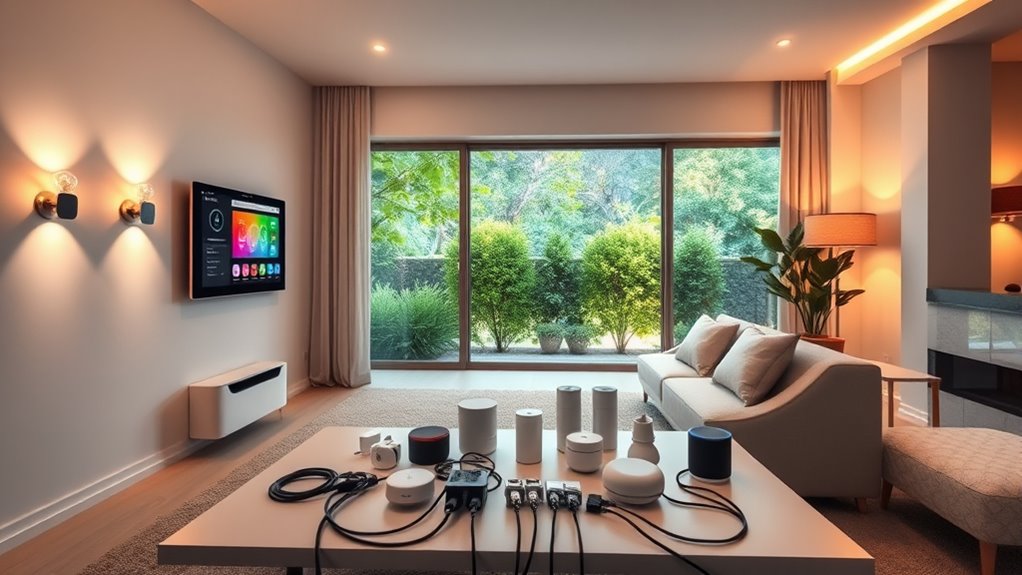
Maintaining and expanding your smart home system guarantees it continues to serve your needs efficiently and securely. Regularly update firmware and software to address security concerns and patch vulnerabilities. Keep your network protected with strong, unique passwords and consider segmenting your Wi-Fi to isolate smart devices. As you add new gadgets, ensure compatibility with your existing setup to prevent conflicts. Focus on energy efficiency by choosing devices that support automation for ideal power use, like scheduling lights or thermostats. Periodically review your automation routines to improve performance and security. Staying informed about new features and security updates helps you make smart choices when expanding. Understanding compatibility considerations is essential to ensure new devices integrate smoothly with your current system. Researching device compatibility helps prevent integration issues and enhances your system’s overall functionality. Additionally, paying attention to security protocols ensures your system remains protected against potential cyber threats. Incorporating remote work strategies can help you manage your smart home system more effectively even when you’re away. Regularly practicing mindfulness techniques can also help you stay focused and reduce stress during system management. With proactive maintenance and thoughtful expansion, your smart home remains safe, efficient, and tailored to your lifestyle.
Frequently Asked Questions
How Secure Is My Smart Home Against Hacking?
Your smart home’s security depends on how well you protect it from hacking vulnerabilities. Strong encryption protocols are essential, as they help keep your data safe from prying eyes. However, if your devices or network have weak passwords or outdated firmware, hackers could exploit vulnerabilities. To stay secure, regularly update your devices, use complex passwords, and enable multi-factor authentication. Being proactive reduces your risk of a security breach.
Can I Integrate Devices From Different Brands Seamlessly?
You’re crossing your fingers that different devices will play nice, but it’s often a game of chance. While many brands now support universal standards like Zigbee or Z-Wave, device compatibility can still be tricky. To guarantee smooth brand integration, check if your devices use common protocols or apps. If they do, you can usually blend them seamlessly; otherwise, you might need a hub or bridge to get everything working together.
What Is the Average Cost of a Complete Smart Home System?
The average cost of a complete smart home system varies based on your desired features and the number of devices. You’ll find different pricing options, ranging from budget-friendly setups to premium packages. Equipment costs typically include smart hubs, lighting, thermostats, and security devices. Expect to spend around $1,000 to $5,000 for a extensive system, but it can go higher depending on the complexity and brand choices you make.
How Does Smart Home Automation Impact Energy Consumption?
Think of your home as a well-tuned orchestra; smart automation ensures every instrument plays in harmony. By using smart devices, you can considerably reduce energy consumption through targeted energy savings, like turning off unused lights and adjusting thermostats remotely. This not only cuts your utility bills but also lessens your environmental impact. Overall, automation empowers you to make eco-friendly choices effortlessly, creating a greener, more efficient living space.
Are There Any Privacy Concerns With Smart Home Devices?
You might wonder if smart home devices compromise your privacy. They often collect data to improve functionality, which raises concerns about data privacy and user tracking. While manufacturers typically implement security measures, there’s always a risk of unauthorized access or data misuse. To protect yourself, regularly update your devices, use strong passwords, and review privacy settings. Staying informed helps you enjoy the benefits of home automation without sacrificing your privacy.
Conclusion
Now that you understand the basics, choosing the right devices, setting them up, creating automations, and maintaining your system, you’re ready to embrace home automation fully. Embrace the convenience, enjoy the efficiency, and experience the comfort that a smart home offers. Keep exploring, keep expanding, and keep optimizing your system to turn your house into a truly intelligent, effortless, and personalized space where technology works seamlessly for you.

